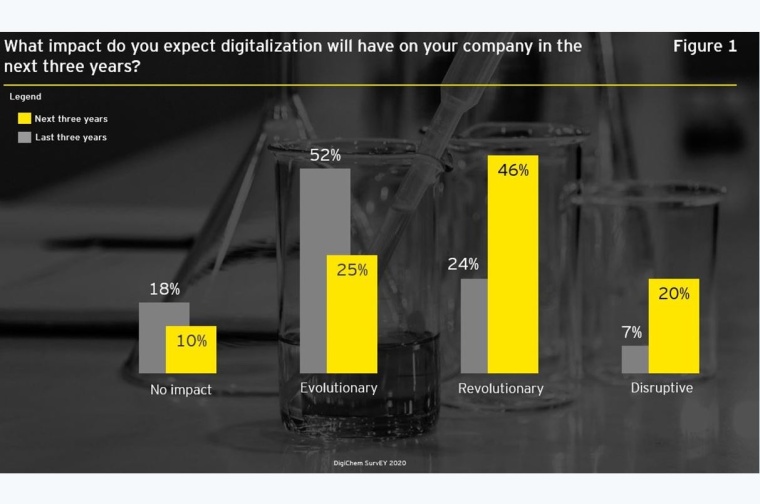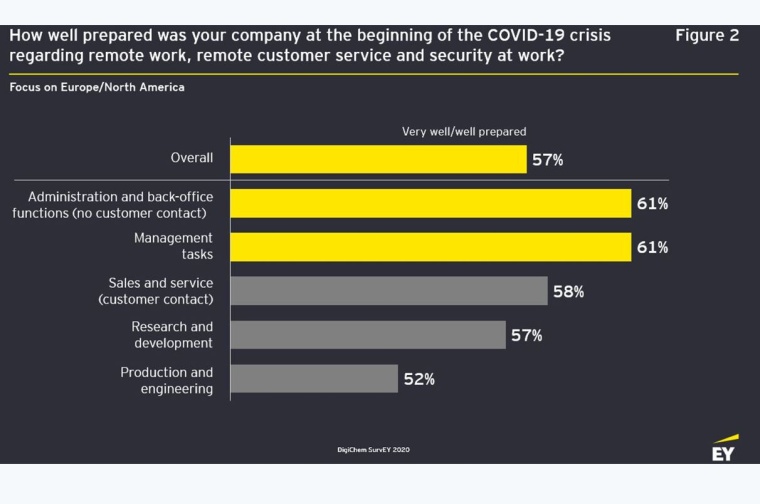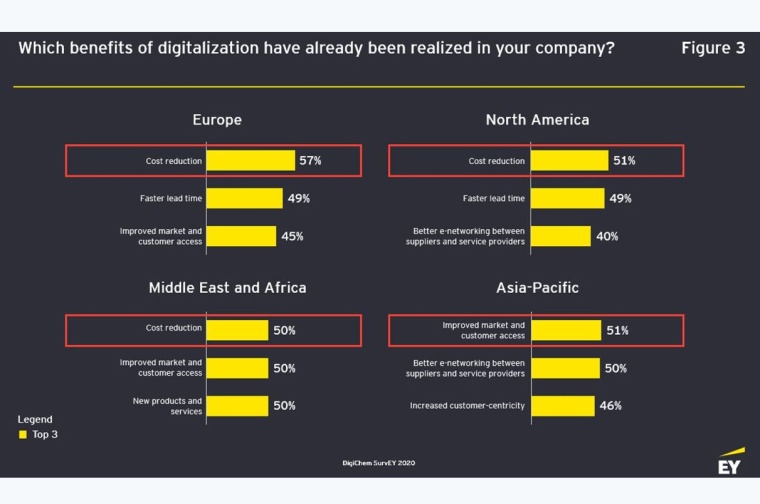Chemical Industry on the Edge of a Disruptive Digital Revolution
While the focus of digitization in Europe and North America is on process efficiency and costs, the focus in Asia-Pacific is on market and customer access.

After other sectors including retail and the music and media industry were already severely shaken by digitalization a few years ago, the chemical industry has so far been largely spared from its fundamental upheavals. The digital transformation got off to a comparatively leisurely start in the chemical industry — without any major shocks to existing business models. But that could change now.
A total of 66% of 369 top decision-makers worldwide participating in the DigiChem SurvEY 2020 expect revolutionary or even disruptive changes as a result of digitalization in the next three years (Figure 1). The noticeable transformation phase is thus imminent.

For the moment, the situation can be described as the calm before the storm. Looking back over the past three years, only 31% of respondents perceived revolutionary or disruptive changes brought about by digitalization. On a scale of 0%–100%, the participants rate the progress of implementation on an average of 63%. However, it should be noted that this value primarily indicates the perceived transformation and not the extent to which companies have achieved their defined goals.
Deeper Transformation Shifts Focus on Central Issues
Medium-sized and larger chemical companies are currently experiencing a profound transformation. It is no longer a question of implementing digital technologies. The goal is now to completely transform existing processes and structures. And this also involves more complex challenges that are being tackled in the longer term. As business models change or new ones emerge and different players in the ecosystem cooperate more closely, new digitalization issues are arising. The degree to which objectives have been achieved should therefore be seen as a snapshot, since on the one hand existing projects are being successfully processed, while at the same time new projects are being initiated.
As the changes have become more fundamental, the focus has also shifted in terms of content. For example, the study participants see a growing influence of digitalization on their companies’ strategic and operational positioning. The strongest influence of digitalization is expected in the areas of innovation and development (56%) and customer interface (56%). The influence on processes and efficiency along the value chain (55%) is also estimated to be very high. Regarding operational competitiveness, the area of logistics and distribution (62%) ranks first, followed by sales and order management (59%) and customer service (58%). Thus, the influence of digitalization is expected to be most noticeable in areas that are directly perceived by the customer. Primarily internal processes such as supply chain planning, production and quality management, and purchasing are farther down the list.
„The effects of digitalization
are shifting more strongly in the direction
of customers, service and logistics.”
Frank Jenner, Managing Partner, Global Chemicals & Advanced Materials Industry Leader, EY
When it comes to the improvements already achieved through digitalization, cost reductions are clearly ahead with a share of 51%. The more tense economic environment and increasing investment in digitalization have certainly also contributed to this. This is followed by faster throughput times (47%) and a stronger customer-centricity (43%). Lastly, improved market and customer access is mentioned, which shows that in this case the digital transformation is still ahead for many companies.
Pandemic as a Practical Test
This year, the Covid-19 pandemic was a test for the progress of digitalization in companies. Within a very short time, they had to switch to remote work, remote customer service and digitize processes that had been analog. For most of them, this was apparently not a problem: overall, 57% of the participants rated their company at the beginning of the crisis as very well or well prepared (Figure 2). Depending on the individual company functions, this varies between 61% who regard administration and back-office management and 52% who regard production and technology as important issues. To be even better prepared for comparable crises in the future, companies want above all to create more transparency about changes (73%), formulate clear rules (70%) and facilitate digital access to information and documents (69%)

International Comparison: Asia-Pacific is Leading
From an international comparison, how advanced are European countries in the digital transformation? In contrast, how far have companies in the North America and Asia-Pacific regions progressed? The survey provides answers to these questions for the first time. According to the results, the participants in the Asia-Pacific region see their companies making progress in implementation by an average of 77%. In contrast, North America (59%) is nearly on a par with the European countries (60%) on a much lower level. It should be noted that among Asia-Pacific participants, the proportion of large companies and the basic petrochemical business segment is significantly higher than in other regions. Parallels between Europe and North America can also be seen in the business areas that are positively affected by digitalization. The participants in these regions see a strong or very strong influence on the operational success of the company — above all on processes and efficiency, customer service, and innovation and development. In contrast, Asia-Pacific participants rate the influence on operational and strategic topics equally high. The impact of digitalization on corporate strategy, portfolio, business models and the depth of value creation is rated much higher in Asia-Pacific than in other regions. Ultimately, this is also reflected in the assessment of the benefits already realized from digitalization (Figure 3).

"As chemical companies in Europe
and North America are focusing on efficiency,
they may miss the market opportunities
of digitalization.”
Sven Mandewirth, Associate Partner, EY
Fine-Tuning Focus to Take Advantage of Opportunities
While other regions put cost reduction first, improved access to markets and customers is a top priority in the Asia-Pacific region. From our analysis, this is a result of the growth ambitions in the Asia-Pacific region and the associated market, and customer orientation. In addition, the high degree of maturity of the chemical regions in Europe and North America, where process efficiency and cost reduction have played an important role in recent years, is also evident. For companies in Europe and North America, however, this also entails a risk: missing out on the new market opportunities offered by digitalization and the digital transformation of their own business model. This closes the circle in terms of process efficiency and cost reduction. After all, significant improvements can often only be realized in a market-oriented and modern business model.
Authors:
Frank Jenner, Managing Partner, Global Chemicals & Advanced Materials Industry Leader, EY, Mannheim, Germany
Sven Mandewirth, Associate Partner, EY, Cologne, Germany
_________________________
About the study
After a successful start in 2019, EY conducted the DigiChem SurvEY for the second time this year in cooperation with an independent market research institute. Designed as a long-term study in the chemical industry, this survey focuses on the implementation progress and added value of digitalization. This year the study was rolled out globally with 369 participants from the main business segments, regions and size categories of chemical companies. Around 46% of the participants come from European countries. To address the special effects of the Covid-19 pandemic, a follow-up survey was conducted in the middle of the year.


Company
Ernst & Young GmbHMittlerer Pfad 15
70499 Stuttgart
Germany
most read

CHEManager International Media Kit 2026
Compelling solutions through strategic partnerships

VCI Welcomes US-EU Customs Deal
The German Chemical Industry Association (VCI) welcomes the fact that Ursula von der Leyen, President of the European Commission, and US President Donald Trump have averted the danger of a trade war for the time being.

Novo Nordisk to Cut 9,000 Jobs Globally in Major Restructuring
Novo Nordisk announced a global workforce reduction of approximately 9,000 positions to streamline operations and reinvest DKK 8 billion (€1 billion) in growth opportunities for diabetes and obesity treatments.

Merck Acquires Chromatography Business from JSR Life Sciences
Merck to acquire the chromatography business of JSR Life Sciences, a leading provider of CDMO services, preclinical and translational clinical research, and bioprocessing solutions.

Dow to Shut Down Three Upstream European Assets
Building on the April 2025 announcement, Dow will take actions across its three operating segments to support European profitability, resulting in the closure of sites in Germany and the UK.











